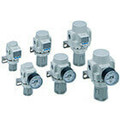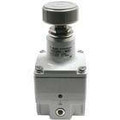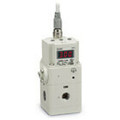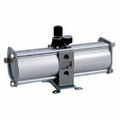Pneumatic pressure Regulators from Orange Coast Pneumatics have been updated to the new urban white base color for a clean modern look. You can monitor air pressure to either reduce or sustain the designated threshold. They have a low learning curve so that any human operator can manage your pneumatic system.
The pressure drop across the regulator has been reduced. This effect creates a more efficient unit with a maximum set pressure of 100 psi. The locking adjustment knob prevents accidental setting changes. Such an arrangement reduces the amount of human error, especially in the case of heavy industrial services.
Types Of Pressure Regulators
Generally, pressure regulators are a type of control valve. They directly regulate the amount of pressure that enters the machine pathways at certain points, and how the air molecules are sustained. As a result, they are important in the case that air is either excessive or too small to meet demand.
A pressure reducing regulator is installed upstream and focus on the input of air. These are better for sensitive environments. A pressure sustaining valve, in contrast, is usually installed to allow air into the machine. It handles downstream pressure.
The AR-A is one of our top air regulators, and one that can replace half of the AR- Special Environment series. There are five different body sizes. AR-B will replace the other half of the AR-Special Environment series.
If you would like a vacuum regulator, try the IRV series. It is designed for portability and compact, to fit into tighter systems. You can also get an adjustment resolution as an additional upgrade.
Do you need an even smaller series, for a compact system? The ARJ series fits the bill, with certain models with or without one-touch fittings. Other options include a pressure gauge and two possible mounting threads.
Options include a mounting bracket and set nuts for panel mounting as well as pressure gauges. The modular design of the AR-A series connects with other SMC air preparation equipment of similar size. Decide if you want threading, port sizes, the addition of a pressure gauge, and other standards. We’ll automatically notify you if a certain combination cannot be produced, allowing you to select an alternative.
Evaluate your temperature range for the environment and the materials that you would prefer. Stainless steel and brass are the general standards. The benefit of stainless steel is that it is long-lasting, waterproof and corrosion-resistant. A high heat threshold ensures that it can handle extreme temperatures. Brass, in contrast, has a smaller temperature range but is affordable and portable. It can be shaped into different substances.
Aluminum is a cost-effective option, if less flexible. Try to only choose plastic if you are on an extremely low budget. They are best when you want disposable regulators, and if the products are not held to high standards. You want to stay safe while controlling input and output pressures.
Industries And Devices That Use Pressure Regulators
Many pressure cookers and gas grills have pressure regulators and for a good reason. If a gas grill doesn’t have a valve that reduces the propane used, then it can lead to real hazards for the person using or anyone nearby, depending on the sparks in the air. Pressure cookers risk explosion if not monitored, and regulators assist with reducing that possibility.
You will also find these precision regulators used in doctors’ and dental offices. A good portion of anesthesia is administered by gas, and an overdose could potentially kill a patient. In contrast, if too little nitrous oxide or another sedative is used, then the person could wait up on the operating table or on the dentist’s chair, risking their health and stress level. For that reason, pressure control is more than necessary. It is a matter of life and death.

Air Regulators
Pressure Regulators from SMC have been updated to the new urban white base color for a clean modern look. The pressure drop across the regulator has been reduced to create a more efficient unit with a maximum set pressure of 100 psi. The locking adjustment knob prevents accidental setting changes. Options include a mounting bracket and set nuts for panel mounting as well as pressure gauges. The modular design of the AR-A series connects with other SMC air preparation equipment of similar size.

Precision Regulators
Precision air regulators offer precise pressure control and pressure adjustment can be critical factors when working with either pressure fed fluids, air pilot regulator supply or during test and inspection applications.

Electronic Pressure Regulators
Electronic pressure regulators control and maintain a desired pressure level in a system or application. They use electronic sensors and controllers to regulate the flow of fluid or gas, allowing for precise and accurate pressure control.
Unlike traditional mechanical pressure regulators, an electronic pressure regulator does not rely on springs or diaphragms to control pressure. Instead, they use electronic components such as sensors, transducers, and solenoids to monitor and adjust the pressure as needed.
Electronic pressure regulators can be used in a wide range of applications, including industrial manufacturing, automotive, aerospace, and medical devices. They offer several advantages over traditional pressure regulators, including faster response times, greater accuracy, and the ability to program and control pressure remotely.
Types of Electronic Pressure Regulators
There are several types of electronic pressure regulators, each with their own unique characteristics and applications. Here are some of the most common types:
Digital electronic pressure regulators
These regulators use a microprocessor to control pressure. They can be programmed with multiple setpoints, and some models offer PID control for even greater accuracy.
Proportional electronic pressure regulators
These regulators, like SMC ITV 1010-33T 1N 1000, use a proportional solenoid valve to adjust the pressure. They are often used in applications such as pneumatic automation and robotics.
Piezoelectric pressure regulators
These regulators use a piezoelectric crystal to control pressure. They are well-suited for applications that require precise pressure control.
Vacuum electronic pressure regulators
These regulators, like SMC ITV 2090-2125N5-Q, control vacuum pressure in applications such as semiconductor manufacturing and vacuum packaging. They use electronic sensors and valves to maintain a desired vacuum level.
High-pressure electronic regulators
These regulators, like SMC ITVH2020-03N2CL4, control high-pressure fluids or gasses, such as those used in oil and gas exploration or hydraulic systems. They often use high-strength materials and advanced sensors to withstand the rigors of high-pressure applications.

Booster Regulators
Booster regulators are indispensable tools for any business seeking high performance pneumatic systems. They allow you to increase the pressure in your main airlines without the need for any electrical input or auxiliary equipment. Unlike many other parts, they don't require a lot of additional accessories to function.
Without booster regulators, your business runs the risk of suboptimal performance of your pneumatic systems, leading to reduced efficiency and speed in your operations.Refraining from using booster regulators also exposes you to potential increase in energy consumption and higher maintenance costs over time.
At Orange Coast Pneumatics, we help professionals get the most out of their pneumatic systems by providing them with high quality tools and equipment. Keep reading to learn all about booster regulators and how they can help enhance your operations.
Why Should You Use Booster Regulators?
Booster regulators are critical for maintaining balance in pneumatic systems. Their primary role is to provide a short-term increase in pressure. This surge in pressure results in faster, more precise operations, leading to increased overall efficiency and cost-effectiveness.
Their unique value lies in their ability to provide high-pressure output, while keeping the input pressure at a lower level. This energy-efficient operation reduces wear and tear on your systems, lengthening their lifespan. With their remarkable adaptability, they are suitable for diverse pneumatic systems, including packaging machines, conveyance systems, and more.
Are Booster Regulators And Air Compressors The Same?
Booster regulators and air compressors may seem similar, but their roles in pressurization processes are different.
An air compressor's job is to generate pressurized air from the atmospheric air, acting as the initial source of pressure. Meanwhile, a booster regulator comes into play after the air compressor, taking the pressurized air and boosting it to a higher level as needed for specific applications. They can increase the pressure to as high as 2000 psi, providing a substantial advantage in a variety of situations.
Booster Regulator Series
At Orange Coast Pneumatics, we offer two series of booster regulators: the VBA and the VBAT.
VBA Series
The VBA series is a line of booster regulators designed to deliver enhanced performance and reliability for your pneumatic systems. Crafted for superior functionality, the VBA series ensures optimal system performance and contributes to the improvement of your operational efficiency.
This series stands out for its capability to provide rapid, precise changes in pressure, offering both versatility and resilience to match a wide range of industrial applications. From its robust construction to its seamless operation, the VBA series combines advanced design and innovative engineering, making it an ideal choice for businesses that prioritize productivity and precision in their pneumatic systems.
VBAT Series
The VBAT series tanks are designed to work in conjunction with VBA boosters to add a reservoir of higher pressure air to the system. This series is engineered for those who require an extra level of power in their pneumatic systems, effectively amplifying operational productivity and efficiency.
This series stands out for its exceptional ability to handle higher pressure levels. It exhibits a robust construction coupled with a user-friendly design, making it both durable and easy to use.
Available in carbon or stainless steel, these tanks come in four sizes ranging from 5 to 38 liters in capacity. Models are available to meet various regional pressure vessel regulations.
Get The Perfect Booster Regulator At Orange Coast Pneumatics
Booster regulators are not just useful; they are essential components for any business relying on efficient pneumatic systems to run its operations. They lead to improved efficiency, speed, and reliability - attributes that every professional values.
By choosing Orange Coast Pneumatics as your source of booster regulators, you're opting for both superior quality and cost-effective solutions. Our unwavering commitment to customer satisfaction and extensive expertise in pneumatic systems make us the ideal partner in your journey towards operational excellence.
Our experts are ready and eager to guide you through the selection process, ensuring you acquire the perfect booster regulator that fits your specific requirements. You can reach out to our team today to get started.

